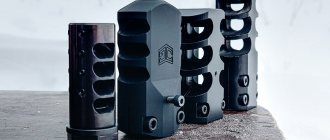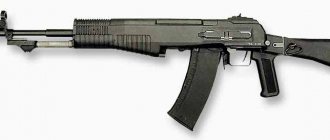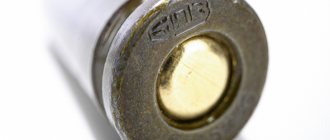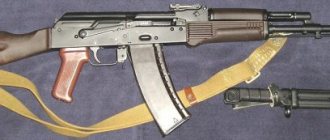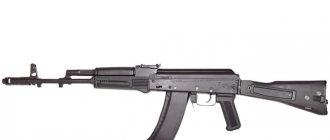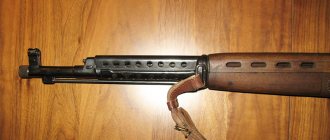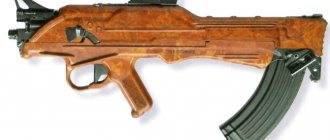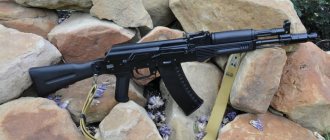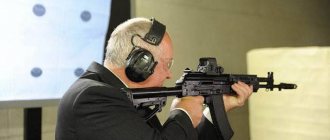Today, November 10, marks the 101st anniversary of the birth of Mikhail Timofeevich Kalashnikov.
The machine gun he created is still the number one brand in the weapons world. More than 70 years have passed since the adoption of the AK into service, but the design of the assault rifle is still actively developing and does not lose its relevance. We talk about the history of the creation and evolution of the Kalashnikov assault rifle: from the AK model 1947 to the new 200th series.
How the invention of the century came about
Mikhail Kalashnikov was interested in invention from an early age, and made his first military developments before the Great Patriotic War, when he served in tank forces. In particular, he created an original design for pistol shooting from a tank. And the idea of creating a light, fast-firing and easy-to-use automatic weapon came to him during a forced break in service - in August 1941, tanker Kalashnikov was wounded and ended up in the hospital. As he later wrote in his memoirs, “the Germans are to blame for the fact that I became a military designer.”
Mikhail quickly fills in the gaps in knowledge and, during his rehabilitation leave, begins to create his first submachine gun. With it, he reaches the stage of shooting tests. The weapon does not pass tests, but Kalashnikov gains valuable experience of getting acquainted with samples of modern small arms, studies their design and testing methods, and communicates with weapons specialists.
Historians consider the starting point for the appearance of the Kalashnikov assault rifle to be July 15, 1943, when at a meeting of the People's Commissariat of Defense it was decided to create a new cartridge of reduced power with a 7.62 mm caliber and an assault rifle for it. A large number of designers took part in the competition, but Mikhail Kalashnikov began work only in mid-1945.
In the fall of 1946, with great help from the team of Kovrov Plant No. 2, Kalashnikov assembled three prototypes, designated by designer and year of creation as AK-46. The Kalashnikov assault rifle, together with the developments of designers Dementyev and Bulkin, is entering the second test round. It was during the modifications to the next stage of acceptance that revolutionary changes were made that made the legendary machine gun the way we know it today.
"A soldier made a weapon for a soldier"
Mikhail Timofeevich said that while working on the AK-47, he and his colleagues sought to get rid of the stereotypes that had accumulated in the arms business. He communicated a lot with ordinary soldiers - the future users of his weapons. Being a private himself, Kalashnikov understood well what characteristics an ideal machine gun should have: in addition to high shooting qualities, his weapon should be convenient and simple. But, as the designer himself said, “to make something simple is sometimes many times more difficult than something complex.”
A shooter with an AK assault rifle during field testing. 1948
The modified AK assault rifle performed better than others in tests and was recommended for mass production. In 1948, the Izhevsk Motor Plant produced the first batch of 1,500 barrels. The following year, the “7.62-mm Kalashnikov assault rifle model 1947” was put into service, and Mikhail Kalashnikov received the Stalin Prize, 1st degree. So a young thirty-year-old sergeant beat venerable scientists in the competition for the main machine gun of the Soviet army. In 1949, Kalashnikov was appointed designer of Izhmash, where he continued to develop his invention.
If in terms of accuracy of fire the Kalashnikov assault rifle was inferior to its rivals in the competition, then it could not be denied survivability. He continued to shoot after being soaked in swamp slurry, falling from a height onto a cement floor, “swimming” in sand and water, and being frozen in refrigerators. Kalashnikov's ingenious design solutions ensured the machine's long life, making it the most popular small arms in the world. The AK-47 design is highly optimized and is still used by designers today.
AKM and AK-74: evolution continues
In the 1950s, the requirements for automatic weapons increased, and the Kalashnikov team presented the new modernized Kalashnikov assault rifle (AKM), which was put into service in 1959.
AKM
When creating this model, the latest technologies were used, including a plastic box, which made it possible to reduce the weight of the weapon by 700 grams. Thanks to the trigger retarder and the new bolt frame, the accuracy and accuracy of fire have increased. The muzzle brake-compensator reduced the jump of the machine gun when firing. The aiming range of the machine gun increased from 800 to 1000 meters. A variant for AKMS paratroopers with a folding metal stock was also developed.
In the 1970s, the armies of many countries came to the need to reduce the caliber of automatic weapons to reduce the mass of portable ammunition and reduce the excess power of the 7.62 mm cartridge. In 1974, the USSR adopted the AK-74 assault rifle, developed by Mikhail Kalashnikov and chambered for a new 5.45 mm caliber cartridge.
AK-74
The bullet speed increased to 900 m/s, thanks to the new muzzle brake the shot became quieter and the recoil was less. Over time, the AK-74 handguard and butt began to be made of plastic. A version of the AKS-74 for landing troops and an AK-74N with a mount for night sights were also developed. It was the AK-74 that took part in the Afghan War and is still used in many countries to this day.
Model of Kalashnikov training assault rifle AK74M-M (folding stock)
Characteristics:
| Manufacturer: | OJSC "Kalashnikov Concern" - Izhmash (Izhevsk, Russia) |
| Caliber: | 5.45 mm |
| Combat prototype: | Kalashnikov assault rifle AK-74M (USSR/Russia) |
| Magazine capacity: | 10 |
| Material: | metal, plastic |
| Length: | 940 / 700 mm |
| Butt: | folding |
| Equipment (?): | machine, store layout, passport (instructions) |
| Certificate: |
Description of the Kalashnikov AK-74M-M assault rifle model:
MMG Kalashnikov assault rifle AK-74M-M , folding stock is a full-fledged product in appearance and overall dimensions, similar to small arms, but not intended for combat missions. The modernized AK-74M is the latest modification in the line of individual weapons of the 1974 model. And today the AK-74M is in service and is in service with the armies of many countries and special forces.
The 5.45-mm Kalashnikov AK-74M assault rifle is a standard individual small arms weapon of the Russian army and other law enforcement agencies.
The model of the Kalashnikov AK-74M-M , the folding stock fully corresponds to the functionality of its famous combat prototype, its complete disassembly and reassembly is available, including disassembling the trigger. The model was made at the Izhmash plant - the same place where military analogues are produced.
Peculiarities:
- the highest possible authenticity with a combat example;
- possibility of assembly and disassembly;
- all moving parts retain the ability to move;
- inability to fire live or any other ammunition;
- impossibility of conversion into military weapons;
- equipped with a mock-up of a 30-round magazine;
- is on free sale - does not require a license to purchase;
- does not require registration after purchase.
The model of the AK-74M-M assault rifle is suitable, first of all, for training in assembly and disassembly and familiarization with military weapons. Purpose: study of the material part of weapons, collecting, use in theater and film productions, reconstructions. According to the certificate, this product is structurally similar to a firearm and is not a decommissioned training weapon!
Video review:
Information about the characteristics, configuration, appearance and color of the product is for informational purposes only.
; they are subject to change by the manufacturer without notice.
In the online store pnevmat24.ru you can buy a Model of the Kalashnikov training assault rifle AK74M-M (folding stock) with convenient delivery throughout Russia by courier, transport company or Russian Post. We also deliver to Belarus. You can check the price and order the product on the website, by phone or write an e-mail.
“Hundredths” and “two hundredths”: new generations of AKs
The modernized version of the AK-74M marked the beginning of the fourth generation of Kalashnikov assault rifles. This model entered service with the Army in the early 1990s and featured a side-folding polymer stock and a universal attachment mount.
The AK-74M became the basis for the so-called “hundredth series” of Izhmash assault rifles, designed for the most popular calibers, including those used by NATO - 7.62x39 mm (AK-103 and AK-104), 5.56x45 mm (AK-101 and AK-102) and 5.45x39 mm. This decision increased the export capabilities of Kalashnikov assault rifles. Models 101 to 104 were intended for export, and AK-105 for Russian law enforcement agencies.
AK-105
In 2011, the development of a new generation of Kalashnikov assault rifles, the “200th series,” began. The AK-12 assault rifle was created as the main weapon of the “Warrior” kit of the future soldier. In the new model, the designers retained all the advantages that made AK the most popular brand of assault rifles in the world: reliability, ease of use and maintenance, high versatility at a fairly low price.
One of the tasks when developing the AK-12 was to reduce the weight of the machine with an already built-in body kit. The second task set by the military was to improve the accuracy and accuracy of fire. The AK-12 also differs from its predecessors in improved ergonomics - it can be handled even with one hand. One of the long-awaited updates is two Picattini rails for mounting sights, flashlights and other equipment. The new machine gun will enter the army at the end of 2022, and export contracts are being implemented.
Modifications of the Kalashnikov assault rifle
It is almost impossible to list all modifications of the Kalashnikov assault rifle produced in different countries of the world. Most of them received completely unfamiliar names, like the Serbian Zastava, the Finnish Valmat, the Egyptian Maadi, the Romanian PA md. 86, Indian INSAS and many others.
Some countries have acquired licenses (mostly members of the Warsaw Bloc) to manufacture AKs, while others produce illegally, from China to the United States.
The degree of modification also varies significantly. For example, the Chinese Type 56 is an exact copy of the AK, and quite a massive one - about 15 million copies were produced. The Romanian machine gun received only minor external modifications - the most noticeable is the modified shape of the forend, which received a pistol grip for ease of holding in automatic firing mode. But the Israeli Galil overcame a more interesting path. Having appreciated the merits of the AK, which was used by the Arabs during hostilities, local designer Israel Galili (born Israel Balashnikov) set to work. Moreover, the license was acquired not for the Russian AK, but for its Finnish clone Valmat, which was modified, resulting in the most famous Israeli assault rifle.
In general, there are a lot of stories about various modifications of the Kalashnikov, and it is simply impossible to list them all in one.
First AK
The first samples of the Kalashnikov assault rifle were put into service in 1949. And they immediately proved their effectiveness - from reliability and ease of maintenance to rate of fire and firepower. The device as a whole was as simple as possible.
Therefore, there is nothing strange in the fact that the weapon became legendary and quickly became in demand in many countries around the world.
| Characteristic | Parameter |
| Caliber | 7.62 |
| Barrel length, mm | 415 |
| Barrel type | Threaded |
| Ammunition type | 7.62x39 |
| Magazine capacity | 30 |
| Shot speed, m/s | up to 710 (depending on ammunition) |
| Rate of fire, rpm | 40 single, 100 burst, 600 technical |
| Power, J | Up to 2100 (depending on ammunition) |
| Aim | Open, consisting of front and rear sights |
| Energy source | Powder gases |
| Weight | 4.3 kg without cartridges |
AKM
However, progress does not stand still. And designers are working painstakingly to create new types of weapons. Therefore, it is not surprising that a decade later, a new, modernized weapon appeared in the army - the AKM, which was designed to replace the usual Kalashnikov assault rifle.
The differences were quite numerous, but at the same time mostly subtle. But overall, they allowed us to take weapons to a new level.
For example, a muzzle compensator appeared - a small protrusion at the bottom of the barrel, which allows you to direct powder gases upward, reducing the toss when firing and increasing the accuracy of fire when firing in bursts.
The use of a new stamped box made it possible to significantly reduce the weight of the weapon. The shape of the butt changed - now it was on the same line as the barrel. Therefore, shooting became more comfortable.
There were other changes, including a new bayonet - shorter and wider than the one that was equipped with the AK. It became more multifunctional - when connected to a scabbard, it turned into wire cutters.
| Characteristic | Parameter |
| Caliber | 7.62 |
| Barrel length, mm | 415 |
| Barrel type | Threaded |
| Ammunition type | 7.62x39 |
| Magazine capacity | 30 |
| Shot speed, m/s | up to 715 (depending on ammunition) |
| Rate of fire, rpm | 40 single, 100 burst, 600 technical |
| Power, J | Up to 2100 (depending on ammunition) |
| Aim | Open, consisting of front and rear sights |
| Energy source | Powder gases |
| Weight | 3.1 kg without cartridges |
AK-74
For a decade and a half, it was AKM that stood guard over the borders of the USSR and many other countries. But over time, more and more experts started talking about the fact that the 7.62x39 caliber has not only serious advantages, but also disadvantages. Therefore, it was decided to start developing a new ammunition with less power.
As a result, a 5.45x39 caliber cartridge was developed. Of course, it also had certain disadvantages (from the possibility of ricochets and simple deflection of the bullet when shooting in dense bushes, to a lesser stopping effect - compared to 7.62). But he also had serious merits. One of these was lower recoil, which makes shooting more comfortable. In addition, an important advantage was the lighter weight of the equipment - now the shooter could carry with him in bulk not 200 rounds of ammunition, but 300, having the same weight. And the higher bullet speed provided much more serious wounds when hitting soft tissue.
In general, the AK-74 assault rifle has received a number of serious improvements compared to the AKM - experts estimate the approximate volume of technological operations at 70%. The trigger mechanism, automation, magazine, as well as other elements have undergone modifications. In addition, the machine gun finally received a convenient muzzle brake-compensator, which diverts sound to the side and makes it difficult to determine the location of the shooter, while at the same time increasing the accuracy of fire.
| Characteristic | Parameter |
| Caliber | 5.45 |
| Barrel length, mm | 415 |
| Barrel type | Threaded |
| Ammunition type | 5.45x39 |
| Magazine capacity | 30 |
| Shot speed, m/s | up to 900 (depending on ammunition) |
| Rate of fire, rpm | 40 single, 100 burst, 600 technical |
| Power, J | Up to 1430 (depending on ammunition) |
| Aim | Open, night sight |
| Energy source | Powder gases |
| Weight | 3.3 kg without cartridges |
AKS-74U
This machine gun is the ideological successor to the AK-74. With all the advantages of the latter, it had quite large dimensions. Handling it while sitting in an armored personnel carrier, car or its body was very problematic. In addition, for the internal troops, the high combat range provided by the long barrel turned out to be unnecessary. But there were no suitable submachine guns in service after the abandonment of PPSh and PPS.
Therefore, it was decided to develop a shortened machine gun. This was the folding shortened Kalashnikov assault rifle. Compared to the AK-74, it has a much shorter barrel, making it easier to handle in tight spaces. In addition, instead of a conventional stock, a folding frame stock was used.
Of course, the aimed firing range suffered sharply because of this, but this was fully compensated by its compactness - for some situations this turned out to be a much more important factor.
| Characteristic | Parameter |
| Caliber | 5.45 |
| Barrel length, mm | 206 |
| Barrel type | Threaded |
| Ammunition type | 5.45x39 |
| Magazine capacity | 30, 45, 60 |
| Shot speed, m/s | up to 735 (depending on ammunition) |
| Rate of fire, rpm | Up to 700 |
| Power, J | Up to 1430 (depending on ammunition) |
| Aim | Open, night sight |
| Energy source | Powder gases |
| Weight | 2.7 kg without cartridges |
AK-74M
Adopted into service right before the collapse of the USSR - in 1991. Equipped with a polymer stock that folds to the left. In addition, the machine gun finally received a mount for installing optics - a dovetail, used by most Warsaw Pact countries. There were also certain internal improvements, thanks to which it became possible to install an under-barrel grenade launcher on the weapon - GP-25 or GP-30.
| Characteristic | Parameter |
| Caliber | 5.45 |
| Barrel length, mm | 415 |
| Barrel type | Threaded |
| Ammunition type | 5.45x39 |
| Magazine capacity | 30 |
| Shot speed, m/s | up to 900 (depending on ammunition) |
| Rate of fire, rpm | 40 single, 100 burst, 600 technical |
| Power, J | Up to 1430 (depending on ammunition) |
| Aim | Open, night sight, collimator |
| Energy source | Powder gases |
| Weight | 3.3 kg without cartridges |
AK "hundredth" series
This series usually includes such assault rifles as AK-101, AK-102, AK-103, AK-104 and AK-105. Moreover, only the last one is intended for domestic use - the first four are intended for export.
All changes compared to the AK-74M are mainly cosmetic. The only significant improvement is the presence of a new fire mode with a cutoff - short bursts of three shots.
They have different calibers - from 5.45 to 7.62. The AK-101 and AK-102, which use the 5.56 NATO cartridge, differ in length - one is regular, the other is shortened. The same is the case with the AK-103 and AK-104, developed for 7.62. And only the AK-105, created for 5.45, is shortened, without having a full-size pair.
| Characteristic | Parameter |
| Caliber | 5.45, 5.56, 7.62 |
| Barrel length, mm | 314, 415 |
| Barrel type | Threaded |
| Ammunition type | 5.45x39, 5.56x39, 7.62x39 |
| Magazine capacity | 30, 45, 75 |
| Shot speed, m/s | up to 735 (depending on ammunition) |
| Rate of fire, rpm | Up to 650 |
| Power, J | Up to 1430 (depending on ammunition) |
| Aim | Open, night sight, optical and red dot sights |
| Energy source | Powder gases |
| Weight | From 3.2 to 3.6 kg without cartridges |
AK12 and AK15
The AK-12 was developed and demonstrated to experts in 2012. Alas, it did not satisfy a number of requirements, showing much worse performance than the outdated machines in the series.
Therefore, in 2016, specialists from the Kalashnikov concern developed a new weapon based on the “hundredth” series assault rifles, which received the same name - AK-12.
There are no major changes to the design, but thanks to numerous small innovations, the ease of handling the machine has increased significantly. Finally, a bolt stop has appeared, allowing you to quickly replace an empty magazine with a new one without distorting the bolt - just pull the trigger to send the pistol into the barrel.
Reducing the recoil shoulder made it possible to significantly increase the accuracy of fire. The shooter also had the opportunity to rearrange the reloading handle - this makes it possible for both right-handed and left-handed people to use the weapon with equal comfort. The Picatinny rail located on the top of the machine makes it possible to install almost any optics. There are three Picatinny rails at the bottom, which allows the use of an under-barrel flashlight or a grenade launcher.
There are three fire modes: single, two-round cut-off and automatic.
The model was accepted for service and began entering the army in 2018. In 2016, it was decided to also create the AK-15, which differs from the AK-12 in caliber - 7.62 instead of 5.45 mm.
| Characteristic | Parameter |
| Caliber | 5.45, 7.62 |
| Barrel length, mm | 415 |
| Barrel type | Threaded |
| Ammunition type | 5.45x39, 7.62x39 |
| Magazine capacity | 30, 60, 96 |
| Shot speed, m/s | up to 900 (depending on ammunition) |
| Rate of fire, rpm | Up to 700 |
| Power, J | Up to 1430 (depending on ammunition) |
| Aim | Open, night sight, collimators, optics |
| Energy source | Powder gases |
| Weight | 3.2, 3.7 kg without cartridges |
AK-308
In fact, this machine gun is a highly modernized AK-103. In many ways, the improvements are minor - like an ergonomic handle, a sliding butt and others.
The main surprise was the cartridge used - completely uncharacteristic for the Russian army 7.62x51, previously used by the armies of the NATO bloc. This makes the machine gun very highly specialized - it is clearly not suitable for shooting with ordinary shooters. But it became a very successful find for the so-called Marksmen - something between a simple shooter and a sniper.
He is not as well trained as a real sniper and cannot hit targets at a distance of one and a half to two kilometers. But it copes well with such a task as destroying the enemy at a distance of about 500-800 meters - for an ordinary machine gunner such a distance is considered prohibitive. In addition, the Marksman is significantly superior to the sniper in rate of fire, and the ease of training makes them increasingly in demand in modern wars.
Due to the increased caliber, the magazine capacity had to be reduced to 20 rounds so that it would not be too long.
| Characteristic | Parameter |
| Caliber | 7.62 |
| Barrel length, mm | 415 |
| Barrel type | Threaded |
| Ammunition type | 7.62x51 |
| Magazine capacity | 20 |
| Shot speed, m/s | up to 715 (depending on ammunition) |
| Rate of fire, rpm | Up to 600 |
| Power, J | Up to 3600 (depending on ammunition) |
| Aim | Open, night sight, collimator, optics |
| Energy source | Powder gases |
| Weight | 4.3 kg without cartridges |

